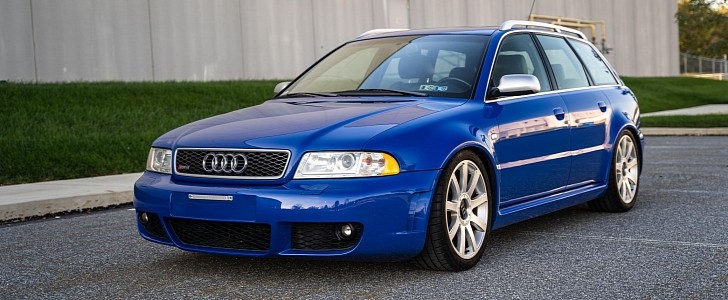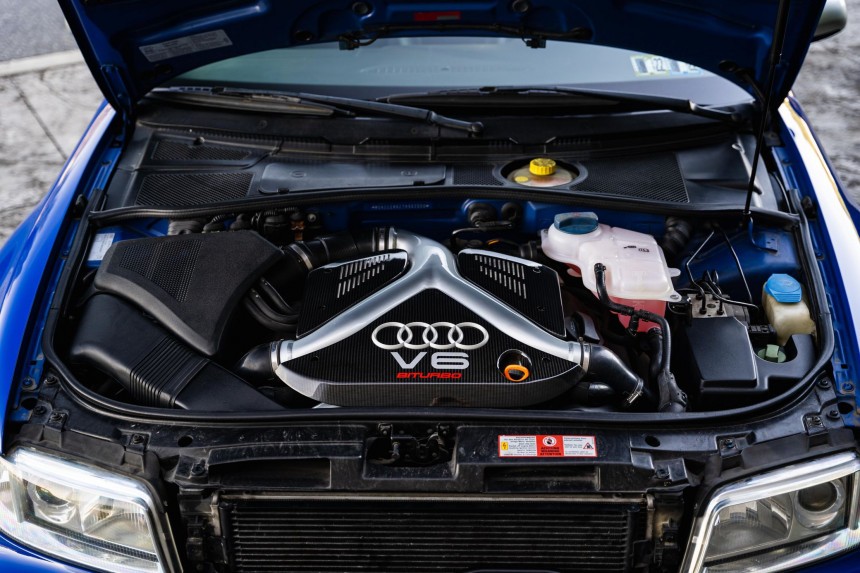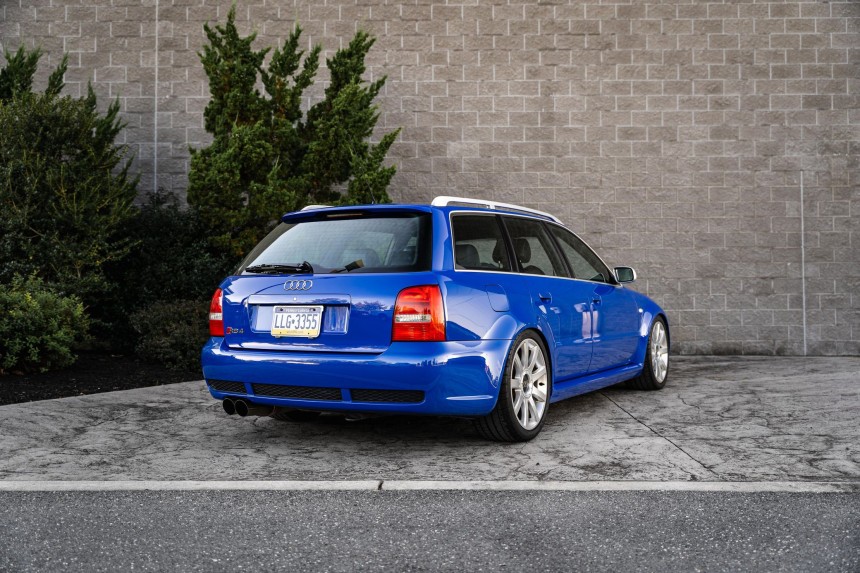Produced by Porsche and Audi at a time when the Zuffenhausen-based automaker’s financial situation was pretty bad, the RS 2 Avant served as the blueprint for the car we’re covering today. Developed by quattro GmbH, a.k.a. Audi Sport GmbH, the RS 4 Avant entered production five years after the assembly line for the RS 2 Avant came to a halt.
Codenamed B5, the first-generation RS 4 was unveiled to much critical acclaim at the Frankfurt Motor Show in September 1999. Production started in May 2000, continuing through September 2001. Audi delivered just over 6,000 examples of the breed. Circa 500 were finished in right-hand drive.
110 kilograms heavier than the S4 at 1,620 kilograms (3,571 pounds), the RS 4 Avant is rocking a pressed steel platform with pressed steel body panels. The 62-liter (nearly 16.4-gallon) fuel tank of the A4 is located under the rear seats, feeding a twin-turbocharged V6 with a 90-degree angle between the cylinder banks. Although it’s based on the bi-turbo sixer of the S4, the 2.7-liter mill features a lot of Cosworth Technology bits and bobs.
Owned by MAHLE since 2005, the Brits gifted this lump with enlarged intake and exhaust ports, a pair of side-mounted intercoolers, and beefier turbochargers in the guise of BorgWarner K04s. By comparison, the S4 employs K03s. The aluminum cylinder heads developed by Cosworth Technology sit atop cast iron for the block. A redesigned exhaust system and Bosch Motronic engine management need to be highlighted as well.
Bosch also supplied the multipoint sequential injection and drive-by-wire throttle. The longitudinally-mounted powerplant further differs from the 2.7 in the S4 by means of a special oil pump designed to prevent starvation while cornering. And oh, by the way, this engine is fitted with five valves per cylinder, just like the aurally pleasing Ferrari F355 midship sports car.
As expected of such a specialized powerplant, many internals are different from the powerplant of the S4. Even the compression ratio was lowered from 9.3:1 to 9.0:1 due to the K04 turbos mentioned earlier, this fellow produces 375 horsepower at 7,000 revolutions per minute and 325 pound-feet (440 Nm) from 2,500 through 6,000 revolutions per minute. By comparison, the naturally-aspirated boxer of the Porsche 911 Carrera from that period makes do with 296 horsepower and 258 pound-feet (350 Nm) of torque.
Somewhat bizarre compared to modern-day RennSport models, the B5 Audi RS 4 Avant is equipped with a good ol’ manual transmission instead of a DCT or a torque-converter auto. The six-speed box works together with a center diff to deliver up to 75 percent of the available torque to whichever axle needs it the most. The Torsen-type quattro permanent all-wheel-drive system usually sends 50 percent up front and 50 percent to the rear axle.
Wider both fore and aft compared to the already sporty S4, the RS 4 dons 18- by 8.5-inch wheels featuring a nine-spoke design. Behind them, you’ll find two-piston brake calipers and 360-millimeter brake discs up front, joined by single-piston calipers and 312-millimeter discs for the rear axle.
The optional winter-spec wheels are marginally narrower at 7.5 inches. Optional extras further include a sunroof, wood accents for the cockpit, Nappa leather, a sunroof, Alcantara for the steering wheel and gear knob, and bucket seats. When it comes to suspension componentry, MacPherson struts are fitted up front whereas the rear end is a double-wishbone setup.
Decidedly prettier than the sportiest variants of the E36 BMW 3 Series Touring and W202 Mercedes-Benz C-Class, the B5 Audi RS 4 Avant was originally fitted with xenon high-intensity discharge headlights. The longitudinal roof rails could be specified in silver or black, and the good peeps in Ingolstadt didn’t cut any corners in terms of standard equipment.
Leather? Check! Air conditioning? Check again! Heated seats? Of course! Electric windows for everyone? Well, duh! Dressed in finely perforated leather, the beautifully minimalist three-spoke steering wheel of the first-generation RS 4 Avant frames an 8,000-rpm tachometer and a 310-kph speedometer. Make that 200 mph if we’re dealing with a UK-spec vehicle.
Never sold in the United States of America, the German superwagon reaches 100 kilometers per hour (62 miles per hour) in just under five clicks. Top speed is limited to 250 kilometers per hour (155 miles per hour), which is good enough for a car that seats five and the family dog.
For some reason or another, Audi couldn’t make a case for the RS 4 Avant on the B6 platform. The Ingolstadt-based automaker wouldn’t let BMW M and Mercedes-AMG have their way for too long, though, because the RS 4 Avant returned in 2006 with a free-breathing, flat-plane crankshaft V8. The B7 is the only generation of RS 4 offered as a wagon and a sedan.
110 kilograms heavier than the S4 at 1,620 kilograms (3,571 pounds), the RS 4 Avant is rocking a pressed steel platform with pressed steel body panels. The 62-liter (nearly 16.4-gallon) fuel tank of the A4 is located under the rear seats, feeding a twin-turbocharged V6 with a 90-degree angle between the cylinder banks. Although it’s based on the bi-turbo sixer of the S4, the 2.7-liter mill features a lot of Cosworth Technology bits and bobs.
Owned by MAHLE since 2005, the Brits gifted this lump with enlarged intake and exhaust ports, a pair of side-mounted intercoolers, and beefier turbochargers in the guise of BorgWarner K04s. By comparison, the S4 employs K03s. The aluminum cylinder heads developed by Cosworth Technology sit atop cast iron for the block. A redesigned exhaust system and Bosch Motronic engine management need to be highlighted as well.
Bosch also supplied the multipoint sequential injection and drive-by-wire throttle. The longitudinally-mounted powerplant further differs from the 2.7 in the S4 by means of a special oil pump designed to prevent starvation while cornering. And oh, by the way, this engine is fitted with five valves per cylinder, just like the aurally pleasing Ferrari F355 midship sports car.
Somewhat bizarre compared to modern-day RennSport models, the B5 Audi RS 4 Avant is equipped with a good ol’ manual transmission instead of a DCT or a torque-converter auto. The six-speed box works together with a center diff to deliver up to 75 percent of the available torque to whichever axle needs it the most. The Torsen-type quattro permanent all-wheel-drive system usually sends 50 percent up front and 50 percent to the rear axle.
Wider both fore and aft compared to the already sporty S4, the RS 4 dons 18- by 8.5-inch wheels featuring a nine-spoke design. Behind them, you’ll find two-piston brake calipers and 360-millimeter brake discs up front, joined by single-piston calipers and 312-millimeter discs for the rear axle.
The optional winter-spec wheels are marginally narrower at 7.5 inches. Optional extras further include a sunroof, wood accents for the cockpit, Nappa leather, a sunroof, Alcantara for the steering wheel and gear knob, and bucket seats. When it comes to suspension componentry, MacPherson struts are fitted up front whereas the rear end is a double-wishbone setup.
Leather? Check! Air conditioning? Check again! Heated seats? Of course! Electric windows for everyone? Well, duh! Dressed in finely perforated leather, the beautifully minimalist three-spoke steering wheel of the first-generation RS 4 Avant frames an 8,000-rpm tachometer and a 310-kph speedometer. Make that 200 mph if we’re dealing with a UK-spec vehicle.
Never sold in the United States of America, the German superwagon reaches 100 kilometers per hour (62 miles per hour) in just under five clicks. Top speed is limited to 250 kilometers per hour (155 miles per hour), which is good enough for a car that seats five and the family dog.
For some reason or another, Audi couldn’t make a case for the RS 4 Avant on the B6 platform. The Ingolstadt-based automaker wouldn’t let BMW M and Mercedes-AMG have their way for too long, though, because the RS 4 Avant returned in 2006 with a free-breathing, flat-plane crankshaft V8. The B7 is the only generation of RS 4 offered as a wagon and a sedan.























































